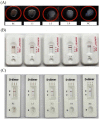Use of Lateral Flow Assays in Forensics
- PMID: 37448049
- PMCID: PMC10346655
- DOI: 10.3390/s23136201
Use of Lateral Flow Assays in Forensics
Abstract
Already for some decades lateral flow assays (LFAs) are 'common use' devices in our daily life. Also, for forensic use LFAs are developed, such as for the analysis of illicit drugs and DNA, but also for the detection of explosives and body fluid identification. Despite their advantages, including ease-of-use, LFAs are not yet frequently applied at a crime scene. This review describes (academic) developments of LFAs for forensic applications, focusing on biological and chemical applications, whereby the main advantages and disadvantages of LFAs for the different forensic applications are summarized. Additionally, a critical review is provided, discussing why LFAs are not frequently applied within the forensic field and highlighting the steps that are needed to bring LFAs to the forensic market.
Keywords: body fluid identification; explosives analysis; forensic investigation; illicit drugs analysis; lateral flow assays.
Conflict of interest statement
The authors declare no conflict of interest.
Figures








Similar articles
-
Analysis of body fluids for forensic purposes: from laboratory testing to non-destructive rapid confirmatory identification at a crime scene.Forensic Sci Int. 2009 Jul 1;188(1-3):1-17. doi: 10.1016/j.forsciint.2009.02.013. Epub 2009 Mar 27. Forensic Sci Int. 2009. PMID: 19328638 Review.
-
Lateral flow assays for hormone detection.Lab Chip. 2022 Jun 28;22(13):2451-2475. doi: 10.1039/d1lc00960e. Lab Chip. 2022. PMID: 35713489 Review.
-
An Overview for the Nanoparticles-Based Quantitative Lateral Flow Assay.Small Methods. 2022 Jan;6(1):e2101143. doi: 10.1002/smtd.202101143. Epub 2021 Dec 2. Small Methods. 2022. PMID: 35041285 Review.
-
Application and Prospect of RNA Profiling Analysis in Forensic Body Fluid Identification.Fa Yi Xue Za Zhi. 2022 Dec 25;38(6):763-773. doi: 10.12116/j.issn.1004-5619.2021.510707. Fa Yi Xue Za Zhi. 2022. PMID: 36914393 Review. Chinese, English.
-
Photoluminescent Molecules and Materials as Diagnostic Reporters in Lateral Flow Assays.ACS Appl Bio Mater. 2022 Jan 17;5(1):82-96. doi: 10.1021/acsabm.1c01051. Epub 2021 Dec 27. ACS Appl Bio Mater. 2022. PMID: 35014811 Free PMC article.
Cited by
-
Unveiling Morphine: A Rapid and Selective Fluorescence Sensor for Forensic and Medical Analysis.Sensors (Basel). 2024 Mar 7;24(6):1722. doi: 10.3390/s24061722. Sensors (Basel). 2024. PMID: 38543983 Free PMC article.
-
Conjugation of visual enhancers in lateral flow immunoassay for rapid forensic analysis: A critical review.Anal Bioanal Chem. 2025 Jan;417(1):15-31. doi: 10.1007/s00216-024-05565-6. Epub 2024 Oct 9. Anal Bioanal Chem. 2025. PMID: 39384571 Free PMC article. Review.
References
-
- Choi J.R., Yong K.W., Tang R., Gong Y., Wen T., Li F., Pingguan-Murphy B., Bai D., Xu F. Advances and Challenges of Fully Integrated Paper-Based Point-of-Care Nucleic Acid Testing. TrAC Trends Anal. Chem. 2017;93:37–50. doi: 10.1016/j.trac.2017.05.007. - DOI
-
- Tang R., Yang H., Choi J.R., Gong Y., Hu J., Wen T., Li X., Xu B., Mei Q., Xu F. Paper-Based Device with on-Chip Reagent Storage for Rapid Extraction of DNA from Biological Samples. Microchim. Acta. 2017;184:2141–2150. doi: 10.1007/s00604-017-2225-0. - DOI
-
- Zhuang B. Development of a Fully Integrated “Sample-In-Answer-Out” System for Automatic Genetic Analysis. Springer; Singapore: 2018.
Publication types
MeSH terms
Substances
LinkOut - more resources
Full Text Sources

